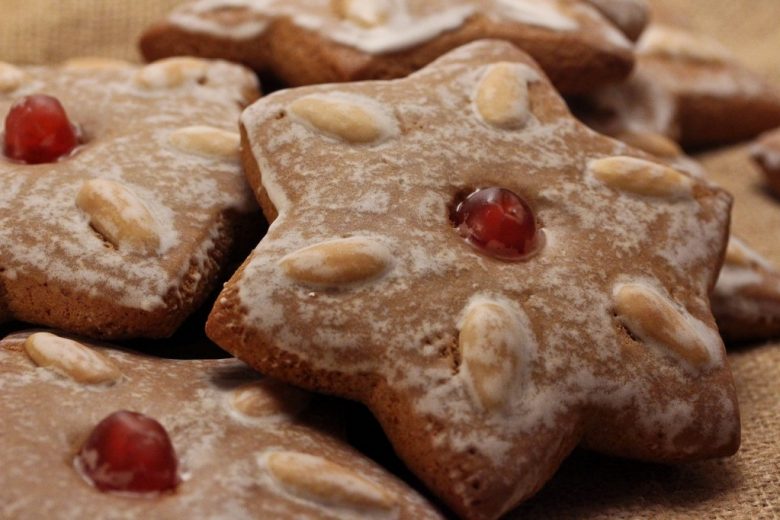Lebkuchen Dough (Gingerbread)
Lebkuchen, also known as Lebzelten, Pfefferkuchen, Gewürzkuchen or Honigkuchen, is a sweet, strongly spiced, pastry with a long shelf-life that is found in many shapes and variations. In many cultures it is an integral part of Christmas baking, though only a few varieties are popular all year round, especially at fairs and festivals. Bakers consider Lebkuchen to be a perennial favorite. Since the dough is made with a long storage dough, I wanted to introduce it sooner rather than later. It won’t be baked for a few days!
Composition:
- Flour
- Honey
- Sugar
- Spices
- Raising agent
Flour:
As with bread, the flour selection has a decisive influence on Lebkuchen production. The variety and quality play a major role, because not all flours are made equal. The flour that is used for the gingerbread should be well aged. If the flour is too strong, adding spelt flour (50%) can help.
Strong Flours: Turn out to be rather bad, because the dough becomes firm and tough. This has the following negative effects:
- Contraction of the dough when rolling out and cutting.
- Blistering
- Smaller Volume
Honey:
Honey gives the biscuits their characteristic taste, and with gingerbread production it is the most important raw ingredient. Honey should only be heated to 60 ° C, otherwise it will lose its flavor very quickly. If overheated, there is even a risk that the ferments will be destroyed, which can affect the dough’s rising ability. Long periods of heating should also be avoided because too much liquid evaporates. The honey then becomes thick and also makes a correspondingly firm and perhaps tough, dough.
Sugar:
Sugar also plays a critical role in the production of gingerbread:
- In the dough, the sugar serves to stretch the sweetness of the more expensive honey; it also helps achieve a better, more uniform rise, shortens the dough a bit and prevents the dough from becoming too tough.
- On the finished cookies, in the form of glaze or decoration.
- In the fillings, to make them sweeter and last longer.
Honey and sugar are usually dissolved together, what is especially important is that this mix is not overheated. The best method is to heat the honey alone, then add the sugar and then pour the mixture directly onto the flour. The honey melts much faster, and thus requires less heat. This preserves the natural ferments of the honey. The sugar also maintains its fermentation power through this process.
If you follow this advice, you can use much less artificial raising agents than usual.
Spices:
Are used as a mixture and normally contain cinnamon, anise, fennel, ginger, cardamom, coriander, mace, nutmeg, cloves, allspice, star anise, etc.
Gingerbread spice mix:
- 18% Anise
- 18% Fennel
- 11% Cloves
- 11% Ginger
- 18% Coriander
- 16% Cinnamon
- 8% Nutmeg
Raising Agent:
Various chemical leavening agents are used to produce gingerbread. These can also be combined. The raising agents are always dissolved and separated from the gingerbread dough and only when the dough has cooled to a maximum temperature of 30 ° C are added.
- Ammonia Carbonate
- Intensive Rise
- Quickly dries out the dough
- Strong smell and taste
- Potassium Carbonate
- Acts as a leavening agent for dough that has been stored for a long time
- Acts as a humectant for dough that has been stored briefly
- Sodium Bicarbonate
- Because of its tendency to have a lye taste it is only used for special recipes e.g. spekulatius.
Egg:
By adding eggs, the gingerbread dough is stabilized and loosens better (emulsion of eggs). Mix the eggs with a little sugar until frothy.
Process of combining ingredients:
- Heat honey to 60°C
- Add the sugar and cool to 40°C
- Add Flour and spices, then mix
- Add eggs and mix
- Raising agents are added at a max temperature of 30°C
Work-up:
Can also be the source of errors. The gingerbread dough should be kneaded a few times before working up. This will improve the evenness of the dough and the uniformity of the final bake.
Don’t use too much flour when rolling out! Floury left overs that are used again will develop bubbles. Thus, the leftover dough bits should be kneaded back into the dough mass.
Before baking the tops are brushed with milk. This gives a nice coloring and a lightly shiny top. Bake in a mild oven heated to 190-210°C without steam.
Storage:
Gingerbread should never be eaten fresh, because it improves in quality when it is stored (3-5 days). Gingerbread can take on foreign smells very easily, so it should be stored in a cool, dark and dry place (lockable cans).
Caution: Watch out for mice !!
Recipe suggestions:
Gingerbread dough with a long stored pre-dough:
Pre-dough:
- 1700g Honey
- 850g Rye Flour Type 960
- 850g Wheat Flour Type 700
Melt the honey, let it cool a bit and then mix with the flour into a dough. Store in a sealed container for 3-4 months (or longer) in the cellar.
Main Dough:
- 1000g stored Pre-dough
- 50g Whole Egg
- 20g Sugar
- 40g Wheat flour or Rye flour
- 30g Water
- 7g Ammonium Carbonate- dissolved separately!
- 3g Potassium Carbonate- dissolved separately!
- 12g Gingerbread Spice
Stir eggs and sugar until frothy, mix in the flour, spices, and raising agents. The consistency of this spiced dough should adjusted depending on how firm or soft the pre-dough is. Work together the pre- and spiced doughs and knead until smooth.
Before working up always test bake, and don’t roll the dough too thick (4-5mm)
Gingerbread without pre-dough
- 500g Honey
- 180g Sugar
- 500g Rye Flour
- 500g Wheat Flour
- 100g Milk
- 10g Potassium Carbonate- dissolved separately!
- 10g Ammonium Carbonate- dissolved separately!
- 13g Gingerbread spice
- 40g Egg Yolks (2)
Heat the money and mix in the sugar. Allow to cool, then mix to a dough with the rest of the ingredients (work until well incorporated). Cover and store for a few days in the refrigerator or in a cool room. Before working up knead again!
Sugar glaze
- 200g Sugar
- 100g Water
Boil until 106°C (85°R), then use a wooden spoon to rub the glaze against the edge of the pot until it becomes milky. The milky glaze goes straight onto the hot gingerbread.
Eingereicht auf YeastSpotting










